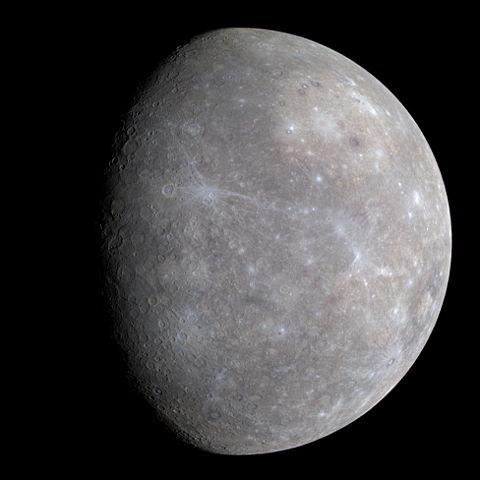From Wikipedia, the free encyclopedia
 Size of this preview: 480 × 480 pixels
Size of this preview: 480 × 480 pixels Full resolution (1,950 × 1,950 pixels, file size: 734 KB, MIME type: image/jpeg)
 |
This is a file from the Wikimedia Commons. The description on its description page there is shown below.Commons is a freely licensed media file repository. You can help.
|
 |
This is a featured picture, which means that members of the community have identified it as one of the finest images on the English Wikipedia, adding significantly to its accompanying article. If you have a different image of similar quality, be sure to upload it using the proper free license tag, add it to a relevant article, and nominate it. |
| Description |
Full colour image of from first MESSENGER flyby |
| Source |
NASA/JPL |
| Date |
2008-01-30 |
| Author |
NASA/ Johns Hopkins University Applied Physics Laboratory/ Carnegie Institution of Washington. Edited version of Image:Mercury in colour - Prockter07.jpg by jjron (cropped to square). |
Permission
( Reusing this image) |
see below |
| Other versions |
Colour version of Image:MESSENGER first photo of unseen side of mercury.jpg.
Cropped version of Image:Mercury in colour - Prockter07.jpg. |
Original caption:
MESSENGER's Wide Angle Camera (WAC), part of the Mercury Dual Imaging System (MDIS), is equipped with 11 narrow-band color filters. As the spacecraft receded from Mercury after making its closest approach on January 14, 2008, the WAC recorded a 3x3 mosaic covering part of the planet not previously seen by spacecraft. The color image shown here was generated by combining the mosaics taken through the WAC filters that transmit light at wavelengths of 1000 nanometers (infrared), 700 nanometers (far red), and 430 nanometers (violet). These three images were placed in the red, green, and blue channels, respectively, to create the visualization presented here. The human eye is sensitive only across the wavelength range from about 400 to 700 nanometers. Creating a false-color image in this way accentuates color differences on Mercury's surface that cannot be seen in black-and-white (single-colour) images.
Color differences on Mercury are subtle, but they reveal important information about the nature of the planet's surface material. A number of bright spots with a bluish tinge are visible in this image. These are relatively recent impact craters. Some of the bright craters have bright streaks (called "rays" by planetary scientists) emanating from them. Bright features such as these are caused by the presence of freshly crushed rock material that was excavated and deposited during the highly energetic collision of a meteoroid with Mercury to form an impact crater. The large circular light-colored area in the upper right of the image is the interior of the Caloris basin. Mariner 10 viewed only the eastern (right) portion of this enormous impact basin, under lighting conditions that emphasized shadows and elevation differences rather than brightness and color differences. MESSENGER has revealed that Caloris is filled with smooth plains that are brighter than the surrounding terrain, hinting at a compositional contrast between these geologic units. The interior of Caloris also harbors several unusual dark-rimmed craters, which are visible in this image. The MESSENGER science team is working with the 11-colour images in order to gain a better understanding of what minerals are present in these rocks of Mercury's crust.
The diameter of Mercury is about 4880 kilometers (3030 miles). The image spatial resolution is about 2.5 kilometers per pixel (1.6 miles/pixel). The WAC departure mosaic sequence was executed by the spacecraft from approximately 19:45 to 19:56 UTC on January 14, 2008, when the spacecraft was moving from a distance of roughly 12,800 to 16,700 km (7954 to 10377 miles) from the surface of Mercury.
Licensing
|
|
This file is in the public domain because it was created by NASA. NASA copyright policy states that "NASA material is not protected by copyright unless noted". ( NASA copyright policy page or JPL Image Use Policy).
Deutsch | English | Español | Français | Galego | Nederlands | Português | Русский | 中文(简体) | 中文(繁體) | +/- |
|
|
|
Warnings:
- Use of NASA logos, insignia and emblems are restricted per US law 14 CFR 1221.
- The NASA website hosts a large number of images from the Soviet/ Russian space agency, and other non-American space agencies. These are not necessarily in the public domain.
- Materials from the Hubble Space Telescope may be copyrighted if they do not explicitly come from the STScI.
- All materials created by the SOHO probe are copyrighted and require permission for commercial non-educational use.
- Images featured on the Astronomy Picture of the Day (APOD) web site may be copyrighted.
|
Original upload log
This image is a derivative work of the following images:
- 2008-02-18T06:16:52Z Superm401 3000x2025 (1325745 Bytes) Reverted to version as of 01:42, 31 January 2008
- 2008-01-31T01:52:50Z Kwamikagami 2072x2025 (1091977 Bytes)
- 2008-01-31T01:42:24Z Kwamikagami 3000x2025 (1325745 Bytes) {{Information |Description=Full color image of Mercury from first MESSENGER flyby |Source=NASA/APL |Date=2008 Jan 30 |Author=NASA |Permission=public |other_versions=colour version of [[Image:MESSENGER first photo of unseen sid
Uploaded with derivativeFX
File history
Click on a date/time to view the file as it appeared at that time.
|
|
Date/Time |
Dimensions |
User |
Comment |
| current |
15:12, 3 June 2008 |
1,950×1,950 (734 KB) |
Jjron |
|
File links
The following pages on Schools Wikipedia link to this image (list may be incomplete):
This file contains additional information, probably added from the digital camera or scanner used to create or digitize it. If the file has been modified from its original state, some details may not fully reflect the modified file.


